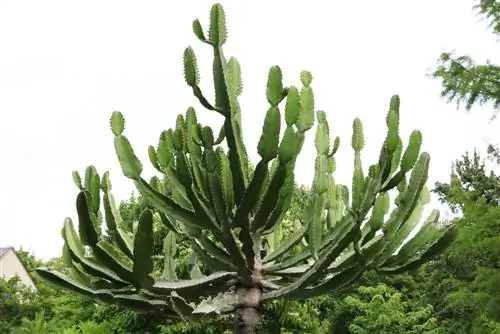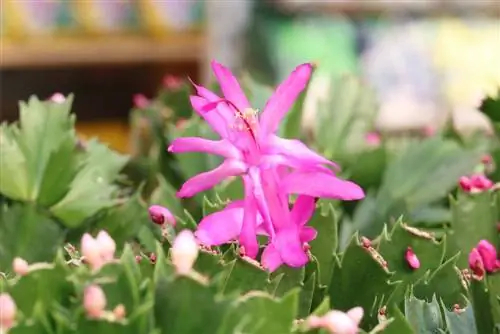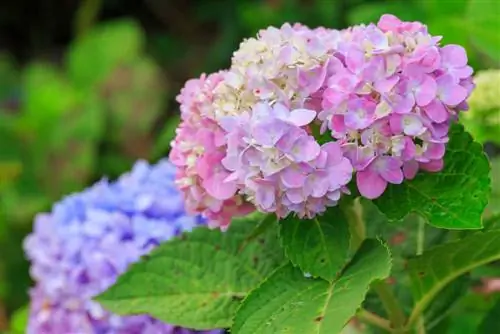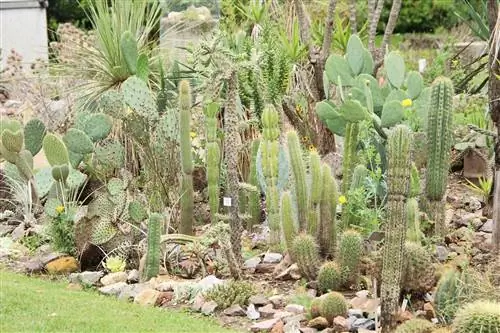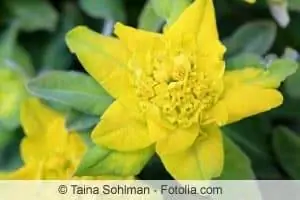- Author admin [email protected].
- Public 2023-12-17 03:39.
- Last modified 2025-01-24 12:45.
The triangular spurge has the botanical name Euphorbia trigona and belongs to the spurge family. Their unusual appearance is reminiscent of a cactus and their care needs also overlap with those of cacti. The succulent houseplant is not winter-hardy, but can tolerate temporary outdoor location in warm temperatures. When cutting, protective measures are always recommended as the milky plant sap is poisonous.
Location & plant substrate
The triangular spurge develops best in a bright and warm place. A location by the window is ideal, but the plant becomes relatively large and usually no longer fits on the windowsill. If the plant is placed too dark, it will result in the growth of long and thin shoots. These shoots can quickly snap. Due to the plant's immense growth potential, its size is crucial when choosing a location. Space quickly becomes limited in small rooms. In a winter garden, however, the spurge plant can spread without obstacles and develop to its full splendor. Since the triangular spurge is a succulent, it needs a special planting substrate for cultivation. This can either be purchased from specialist retailers or made yourself.
- Full to partial sunny locations are ideal
- At least 3 hours of sun per day are perfect
- Also tolerates bright locations without direct sun
- Alternatively, light partial shade is possible
- South and west facing windows are preferred
- Is ideal for the heated winter garden
- Cactus soil from specialist retailers is ideal
- A mixture of potting soil with clay granules and sand is possible
- Make sure the substrate is well drained
Tip:
During the summer, Euphorbia trigona can be moved to the balcony, terrace or garden, but protected from rain. To prevent it from burning, the triangular spurge must be slowly accustomed to the blazing sun.
Planting & Repotting
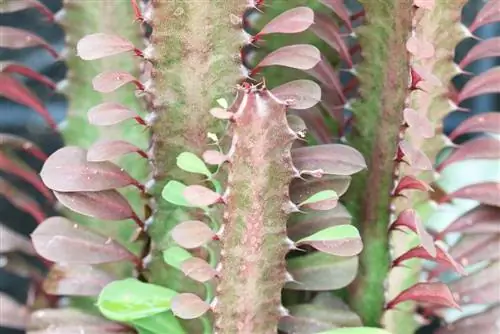
The triangular spurge can only be cultivated in a bucket in these latitudes as it is not hardy. Due to the possible size of the plant, a base with wheels is very practical. Otherwise, moving will be very difficult due to the high weight. In this way, the plant can be moved to a covered balcony or a rain-protected terrace in summer. In winter it is much easier to find suitable winter quarters. Since waterlogging is not tolerated at all, it is recommended to create drainage when planting. If the planter has become too small over time, repotting is advisable.
- Spread pottery shards or gravel over the drain hole
- Lay plant fleece over it to prevent blockages caused by soil
- Apply either prepared potting soil or pre-mixed cactus soil
- Insert the plant and fill in the remaining plant substrate
- Press carefully and pour well
- Choose a sufficiently large container for repotting
- Proceed in the same way as when planting
Watering & Fertilizing
The triangular spurge originally comes from Malawi and Gabon and is used to dry conditions at times in its home countries. However, the plant needs sufficient water during the growth period, otherwise it will grow poorly. Dry periods lasting several days do no harm, but they often cause the leaves to fall off. To prevent root rot, the plant should not be watered from above, but should be able to absorb the water it needs through the roots. To do this, place the planter on a deep plate and fill it with water. To avoid waterlogging, pour off the excess water after a while. Between waterings, the soil should always dry out completely before the next session. In this way, signs of rot can be avoided, which can lead to the death of the plant. In addition, the triangular spurge requires sufficient nutrients during the summer months. But you should also use fertilizer sparingly and carefully.
- Water thoroughly from April to September
- Doesn't tolerate waterlogging at all
- Make sure to put drainage in the bucket
- Never leave water in the saucer
- Water little or not at all in the winter months
- Fertilize only during summertime
- Fertilize once a month with half concentration
- Do not fertilize in winter
- Cactus fertilizers are ideal
- Do not fertilize new plants in the first few months
Cutting
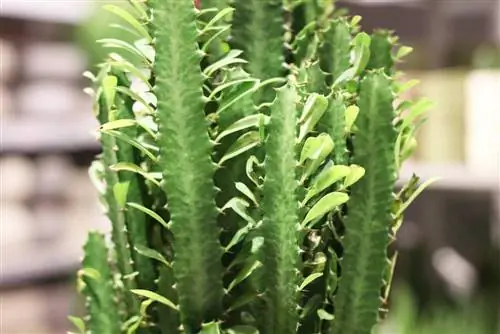
The Euphorbia trigona can reach gigantic dimensions that can quickly exceed the space available indoors. It is therefore advisable to prune in a timely manner to limit height growth. In addition, cutting also promotes the branching of the individual shoots. Otherwise the plant only grows upwards in straight columns. The cutting measures must be placed carefully, as the resulting scars remain visible for a very long time and worsen the appearance of the plant. The new shoots always develop below an interface and only cover the scars after a few years. In addition, a lot of milky plant sap escapes from the interface, which can weaken the plant. Since this juice is poisonous, small children and pets should not be left in the same room without supervision.
- Stop excessive growth by cutting back
- Tolerates cutting well
- Always make cuts so that they are not immediately visible
- Plant loses a lot of sap when cut
- Due to the toxicity, it is essential to take protective measures
- Always work with impermeable gloves
- Make sure you wear long-sleeved clothing
- Always wear rubber gloves when carrying out other care procedures
- Put a cloth with hot water on the interfaces
Wintering
The Euphorbia trigona can be left in an evenly warm location in the room during the winter months, then it will not overwinter. Significantly lower temperatures are required for overwintering. The triangular spurge tolerates both approaches equally well. The sensitive plant must under no circumstances be left outdoors in the winter, as it would die due to the cold temperatures. When growing indoors, water carefully during the cold season so that the plant can stop growing. If it is in a partially shaded location, significantly less water is required.
- Not hardy
- Either stays in the room or moves to winter quarters
- In winter quarters, cool temperatures of 10°-15° C are ideal
- Wate significantly less at room temperature
- When the room temperature is low, almost stop watering
- Stop fertilizer application completely
Propagate
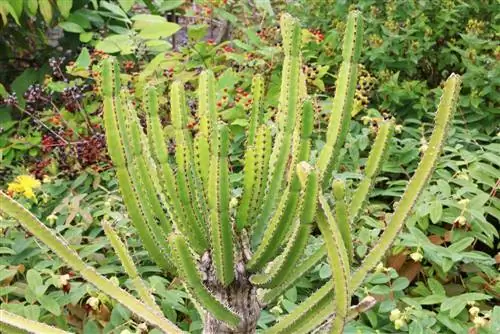
The triangular spurge can be easily propagated through head cuttings. The cuttings required for this are first cut off from the mother plant. For this reason, it makes sense to carry out pruning and propagation at the same time and to combine them with each other. In order for the cut plant parts to root well, they need special treatment. After planting, the cutting must not be given too much water, otherwise it will rot before roots can even form.
- Leave the cuttings for a few days after cutting them
- There should be no more sap coming out
- Let the interface dry thoroughly
- Plant the cutting directly into a planter with prepared and porous soil
- Roots form directly in the ground after a while
- Wate only moderately and carefully
- It's better to keep plant substrate dry rather than too moist
- A bright and warm location is ideal
- For example, a south-facing window sill
Diseases & Pests
The succulents are considered relatively robust and therefore no diseases are known to occur with them. However, signs of rot quickly occur if too much is watered. The triangular spurge cannot cope with this at all. Once this begins to rot, the plant can often no longer be saved and dies. Mealybugs can occur as pests, especially if the plant's immune system is weakened by too many watering sessions or after pruning.
- Always remove water from the saucer after pouring
- Always let the soil dry out from time to time
- Is susceptible to mealybugs
- Insects sit on the plant like little pieces of cotton
- Both on the columns and on the leaves
- Wash carefully with soapy water
- Combat heavy infestations with commercially available products

